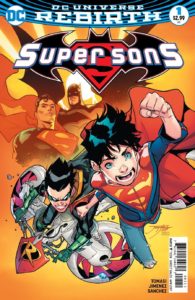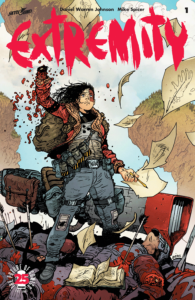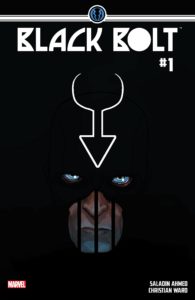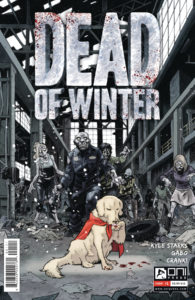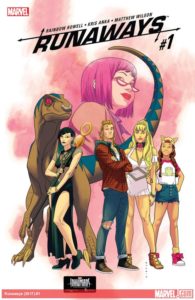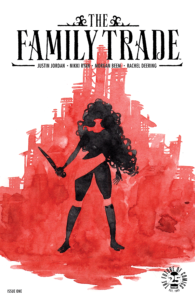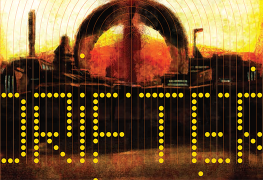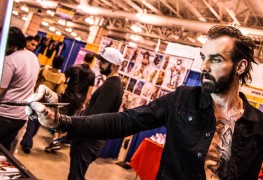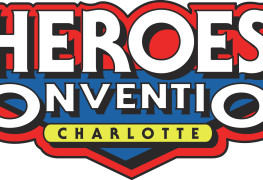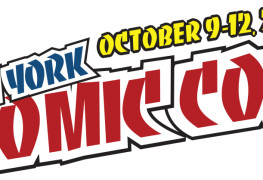After switching to its now bi-monthly release schedule, Doomsday Clock returned last week with Issue #4, which picks up straight after last issue’s cliffhanger ending and focuses on the origin of the mysterious new Rorschach. The story jumps between Rorschah’s previous stay in a mental asylum post-Watchmen and his current incarceration in Arkham Asylum.
Of the two plot lines to follow, the flashback story is the most intriguing. Following the newer Rorschach after the New York attack it’s revealed that not every person exposed to the “alien invasion” died instantly. Many suffered from horrific visions and are left severely traumatized. One of these victims is Reggie, a young man whom writer Geoff Johns wisely connects to the original Rorscach through his relationship to his father. Providing Reggie with an interesting perspective on a character most others consider to be a crazed vigilante.
Symmetry as a theme is present throughout this issue in both the art and writing, with Reggie’s confinement in both timelines mirroring one another and obligatory nods to Walter Kovac’s capture in the original Watchmen. Reggie’s decision to spare Ozymandias towards the end is an example of a man not beholden to the same strict code of his predecessor allowing the character to share many of the same traits but with an added element of unpredictability. Where the story diverges, however, is with the introduction of Mothman.
Mothman is used skillfully by Johns not only to provide a mentor for Reggie, but also as an explanation for how he was able to assume the persona of a new Rorschach and obtain the tools required to confront the man responsible for his parents death.
As a character, Mothman provides a warmth and humour in what would be an otherwise dreary setting. Mothman’s eventual fate is heartbreaking in it’s execution, as are his letters to an estranged sister, which serve as this issues epilogue. This is a character whose inclusion could verge too far towards fan service in another writers hands, but thankfully Johns allows the character to be an essential part of the narrative instead of a throwaway gag or lazy reference.
Another character who arrives in the final few pages is Saturn Girl, something of a reward for fans who have been reading DC Rebirth since its launch. Up until this point, Saturn Girl had only appeared in small cameos, hinting at a connection to the wider Doomsday Clock story. It’s nice to see threads like this finally begin to converge, even if her escape from Arkham could throw up more questions than it answers. The final page delivering an image guaranteed to leave readers discussing its symbolism and implications for the narrative going forward.
It is now a given to say that Gary Frank’s art continues to impress this issue. Mothmans late night flight is the obvious highlight and the overall pacing and detail of each page once again compliments Johns writing perfectly, demonstrating a symbiotic storytelling relationship similar to the one shared by Alan Moore and Dave Gibbons. Frank’s smaller details, such as the halls of Arkham resembling those in The Killing Joke, is a delightful example of these two creators weaving a DC universe intrinsically connected to Alan Moore’s previous work.
Doomsday Clock continues to be THE comic book event of the year. If Geoff Johns and Gary Frank continue this level of quality for the entire run, it’s sure to be considered a modern classic.
 Adventure stories for children starring children will never go out of style. From Alice’s Adventures in Wonderland to The Neverending Story to Goonies, there’s a great thrill in young ones being able to see themselves as the protagonists in exciting situations. The Lost Path by Amélie Fléchais is one such tale in which a trio of boys find themselves in the thick of a secret world of strange and wondrous creatures, but how does it measure up to some of the classics?
Adventure stories for children starring children will never go out of style. From Alice’s Adventures in Wonderland to The Neverending Story to Goonies, there’s a great thrill in young ones being able to see themselves as the protagonists in exciting situations. The Lost Path by Amélie Fléchais is one such tale in which a trio of boys find themselves in the thick of a secret world of strange and wondrous creatures, but how does it measure up to some of the classics?
With some writing help by Jonathan Garnier, The Lost Path is written and illustrated by Fléchais. The book opens with a fairy tale of an older couple whose spirits are trapped by the forest before it quickly transitions to boys playing a scavenger hunt in the forest. They get lost and as the night grows darker, they find their situation growing stranger as they move deeper into the forest.
The story itself feels heavily influenced by Where the Wild Things Are, a notion that is supported by the Maurice Sendak quote that proceeds the book. The boys interact with the creatures, not understanding the world that they’ve arrived in, and with no understanding of the dangers they face. In addition to this, I find a lot of influence from Alice’s Adventures in Wonderland in the way the plot revolves around the forest guardian and the quest for the crown. Both of these are ideal stories to draw inspiration from for a children’s book of these sorts as they are seminal classics, but I don’t think Fléchais really handled the interpretation of the themes properly.
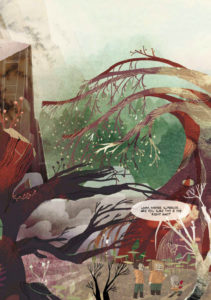 The problem with the story is that the boys don’t do anything. They’re simply reacting to everything that happens around them. They don’t learn any lessons, they don’t affect the world in any way. Their only purpose is to witness the events and they, and by extension the reader, don’t get the chance to see anything through to the conclusion. That’s one of the major shortcomings of the book, in that the story doesn’t really matter. (We don’t even discover the outcome of the scavenger hunt.)
The problem with the story is that the boys don’t do anything. They’re simply reacting to everything that happens around them. They don’t learn any lessons, they don’t affect the world in any way. Their only purpose is to witness the events and they, and by extension the reader, don’t get the chance to see anything through to the conclusion. That’s one of the major shortcomings of the book, in that the story doesn’t really matter. (We don’t even discover the outcome of the scavenger hunt.)
One of the things that turned me off most about The Lost Path was its abrupt ending. While the kids’ journey is an interesting one, the characters they meet are far more intriguing, but Fléchais never dives into any of them. I wanted to learn more about the fox and his supersonic bike, or the moose and how he got the bowler hat, or even what the deal was with the hat. Unfortunately, all of these characters are just incidental, there to give the boys a sense of wonder. Since the story is told from the perspective of the boys, once they are out of the woods, we lose all connection to these strange and wondrous creatures. Their tales are never finished and that’s just a shame.
The book’s art is breathtaking. The illustrations by Fléchais are magnificent and really bring her world and characters to life. Her style suits the creatures she’s created and I love the spin she gives the look of the humans. Each of the boys is unique and easily decipherable at a glance. I also loved the sparse use of color in the book. Most of the pages are black and white, rendered in great detail, but every so often readers are treated to a page of full, vibrant color, which makes the scene more dramatic when juxtaposed against the monochrome panels.
 The art also does a great job of slowing down the reader. The Lost Path has a very fast paced story, with so much happening in so few pages that it’s easy to breeze through the whole thing, but the highly detailed art forced me to pause and pour over the details in the minutiae on page, which helped me to digest the story better.
The art also does a great job of slowing down the reader. The Lost Path has a very fast paced story, with so much happening in so few pages that it’s easy to breeze through the whole thing, but the highly detailed art forced me to pause and pour over the details in the minutiae on page, which helped me to digest the story better.
The Lost Path is beautiful visually but doesn’t pack much originality. I would have preferred to spend more time with the Guardian, learning about her kingdom, or some of the animals in the forest. It was slightly disappointing that Fléchais gleaned over all of these interesting situations and themes, instead focusing on the boys finding their way home. I understand her decision, though, as this story felt aimed for children. All in all, it’s a good story for those who are interested in child adventure stories but doesn’t offer much depth.
Grade: B-
Jen Wang is a cartoonist, author and illustrator from Los Angeles and is the creator behind Koko Be Good and co-author of the New York Times Bestselling graphic novel In Real Life with Cory Doctorow. Her latest book, The Prince and the Dressmaker, hit shelves on February 13th, 2018.
The Prince and the Dressmaker revolves around Prince Sebastian as he searches for a bride―or rather, his parents are strong arming him into finding one. However, Sebastian has a secret life: at night he puts on daring dresses and takes Paris by storm as the fabulous Lady Crystallia―the hottest fashion icon in the world capital of fashion!
Sebastian’s secret weapon (and best friend) is the brilliant dressmaker Frances―one of only two people who know the truth: sometimes this boy wears dresses. But Frances dreams of greatness, and being someone’s secret weapon means she has to stay a secret forever. It’s a romantic tale of identity, young love, art, and family.
We met up with Jen after a book signing at Emerald City Comic Con in Seattle.
LC: I wanted to talk a little bit about your protagonist and why you chose to make him exist outside of the heteronormative, cookie cutter, sort of hero. What was your reason for making him fluid?
JW: I think I just felt like…for a while I was looking for a story that would be like a positive Disney movie romantic comedy. Then I wanted to make sure it was a little more contemporary that felt a little queer. I had the idea of a character that would have this clear passion that people could relate to, even if they didn’t have a gender variant identity themselves. If you understand that Sebastian is into fashion and big dresses, that could be something anyone could relate to.
LC: You both wrote and illustrated the book, correct?
JW: Yes!
LC: Was it a conscious decision to make Sebastian unconventionally handsome compared to romcom heartthrobs?
JW: Yeah! I mean, the character is a teenager and I wanted him to look like a teenager. I didn’t want him to be super handsome or too adult looking or too sexy. Not that a teenager can’t be sexy, haha. I wanted to show the version of yourself when you’re still trying to figure out who you are. There’s a lot of recognition in a character who looks like someone you can relate to. I feel like most people seem themselves as conventional looking. The only thing I wanted to make sure to do was to give Sebastian a prominent facial feature . There’s so many costume changes; I didn’t want people to lose the character in a room full of ballgowns.
LC: How did you choose the time period for the book?
JW: The book takes place in the late 19th century and I wanted a time frame that would be sort of old-timey with people in corsets and horse drawn carriages. At the same time, I wanted there to be an emergence of technology. The 19th century had both of those things for me.
LC: Did you pull from any fashion designers as inspiration for your costume designs?
JW: I did research on clothing from the time period. I looked at a lot of historical cosplay costumers online, particularly accessories. There’s a ton of resources for that. The rest I tried to make a bit more modern like something people would wear now.
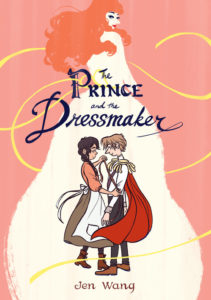 LC: Was it important for you to make the story accessible in every way, versus something that was more queer or adult?
LC: Was it important for you to make the story accessible in every way, versus something that was more queer or adult?
JW: You know, I wanted to make a book that I could read at 13 or 14. It was always the intention, I think. I didn’t really know that much at that age other than what cartoons I liked and what fantasy books I loved.
LC: When you were a teenager, were there any properties that felt accessible to you?
JW: I was really into anime and manga, which I discovered in middle school and high school. I had a friend who was Japanese who had a lot of that stuff. That was before you could find it at the library or in bookstores, haha. It’s actually how I got into comics in general. The thing that was the most influential to me was Revolutionary Girl Utena. I think you can see some overlapping themes in my stuff. It was the first thing I ever read that was queer and unabashedly feminine. I’d never read comics like that before. That was very influential to me.
LC: As someone who also got into comics through manga, I don’t think there was anywhere near the representation you see in that medium as far as the genres of stories you could experience.
JW: There was so much more aimed at teenage girls! I felt completely ignored by American publishers.
LC: I wanted to ask a little about the relationship Sebastian has with his parents. Was that something you drew from real life experiences or just something you wanted Sebastian to go through?
JW: It was something I wanted to have in the book. My parents have always been supportitve of me, but I did ultimately want his parents to accept him despite where they start off. People can change and overlook those prejudices for someone they love.
LC: Is there a comic out that you would like to recommend? Perhaps something recent that might be overlooked?
JW: I really enjoyed Spinning. It reminded so much of how it was like to be a teenager. It felt very real.
—————————————————————————————————
The Prince and the Dressmaker is available wherever graphic novels are sold near you!
How do you follow up an almost flawless first issue of Doomsday Clock, that not only established a new status quo for the world of Watchmen but also seamlessly integrated a mystery involving Superman? Don’t forget with art and writing that feels like Moore and Gibbons never left.
Well, if you’re Geoff Johns and Gary Frank, having Rorschach eat Batman’s breakfast isn’t a bad place to start. But we’ll get to that.
Issue #2 of Doomsday Clock picks up right where we left Ozymandias, Rorschach, Marionette and Mime. Sticking with the classic 9 panel grid for most of this opening, we start in Nite Owl’s abandoned basement and are shown two interweaving stories. Mime and Marionette are carrying out a heist gone wrong some time in the past, and Rorschach and Veidt in the present debating the merits of trusting two hardened criminals to save the world.
The arrival of Dr. Manhattan during the heist is a fun unexpected moment that reveals why Marionette is such an integral part of Ozymandias’ plan. Whether or not he’s fully aware of why Manhattan spared Marionette’s life remains to be seen. It certainly appeared that Manhattan was hesitant to kill a pregnant woman. This contrast nicely echoes the Vietnam sequence of the original Watchmen where The Comedian demonstrates he has no such qualms.
Then it’s off to the DC universe without a moment to spare as the Watchmen’s world is nuked into oblivion. This whole segment felt rushed and convenient compared to the rest of the issue. Perhaps I was hoping for a more intricate system for travelling between dimensions than a throwaway of, “Oh, its ok, I’ve installed a new button in the Owl ship”.

However, this is only a minor gripe as I can understand that Johns is more interested in showing how these characters interact with the DC universe than how they get there. What’s more interesting is where the Watchmen initially land, in an almost exact reproduction of the funfair from The Killing Joke. It’s a nice nod to Alan Moore’s other DC work and potentially an indication of the way Johns intends to characterize Batman and the Joker for the rest of the story.
Here is where our team splits, as Ozymandias and Rorschach attempt to recruit Bruce Wayne and Lex Luthor to their cause, whilst Mime and Marionette are restrained aboard the Owlship. At this point, Gary Frank’s art goes from good to great, as we are treated to some brilliant visual storytelling, mixing Watchmen inspired visual cues with Geoff Johns’ humour and wit. The Owlship bursting through the Bat Symbol and Rorschach’s exploration of Wayne Manor are particular highlights. Rorschach being distracted by a free breakfast leading to him notice a tell tale breeze under the grandfather clock is an amusing and appropriate way for that character to unearth Bruce Wayne’s big secret.
Ozymandias on the other hand has less luck convincing Luthor, who has reverted back to his evil business tycoon demeanor that readers have not seen since before Forever Evil. Luthor questioning Ozymandias’ intelligence after having the plot of Watchmen explained to him feels like Johns winking to the reader about the more ridiculous aspects of that series finale.
We are then left with not one, but three, cliffhangers as a seemingly resurrected Comedian attacks Luthor, Mime and Marionette escape into Gotham City, and Rorschach is confronted by a hungry Batman. Hopefully the Comedian’s appearance is not all it seems, as I feel that bringing back this character undermines the importance of his murder in the original Watchmen. Perhaps it’s tied to Ozymandias brain tumor. We can only wait and see.
Overall, this issue continues the high quality established by the first, with John’s doing an admirable job of echoing the writing style of Alan Moore and Gary Frank bringing beautiful and inventive imagery to every page. My only negatives being the protagonists convenient journey to Gotham and the reappearance of the Comedian, though these do not detract from the story overall. I look forward to seeing where this story goes next and how one gruff vigilante will come to terms with another gruff vigilante eating his pancakes.
The comics industry went through a lot of growth in 2017, some of it good and some of it bad. Through shifts in-universe, massive story events such as Marvel’s Generations and Legacy initiatives to DC’s Doomsday Clock, and questionable PR decisions from most of the big publishers, comics as a whole seemed kind of shaky.
Luckily, the year also saw a bevy of new and old voices, many of whom find themselves on our list of top comics of 2017. We left off ongoing series and chose to focus on new stories and creative teams, all of which you can find at your local comic store! In no particular order, here are our top 10 comics of 2017!
 Angelic
Angelic
Art: Caspar Wijngaard
Super Sons
Extremity
Story/Art: Daniel Warren Johnson
Extremity is so damn special. Most issues leave me in my feelings, or swearing while holding my head in my hands, but it’s definitely one you MUST pick up. It’s Mad Max Fury Road meets Avatar the Last Airbender. It’s kinetic and brutal. I actually don’t want to say too much about it because it’s that good and I don’t want a single bit spoiled for you. Bonus: it’s only $10 for the first trade!
Steven Universe
Story: Melanie Gillman
Art: Katy Farina
Fans of the Cartoon Network show, rejoice! This ongoing series perfectly captures the voices of the characters and it’s episodic, meaning you can pick up any single issue off the shelf and have a complete standalone story. It’s great for little ones who may want to get into comics and hardcore show enthusiasts as well. There’s currently one collected softcover out too, just in case that’s your preference!
Batman: White Knight
Art/Story: Sean Gordon Murphy
Yes, I know a lot of you are tired of rehashed Batman stories featuring the same old formula of Batman beating up the bad guy and saving the city of Gotham. HOWEVER, the Batman: White Knight mini-series turns it all on its head in a refreshing, dark way. The series is about halfway through, but it makes a very big impression every issue. Be sure to pay close attention to those busier panels; Murphy tucks details in every corner. Issue #1 may be a little elusive to track down if you’re intent on a first printing, but it will definitely stay on your mind for a while after reading it.
Fence
Story: C.S. Pacat
Art: Johanna the Mad
If you need something to fill the Yuri!!! on Ice shaped hole in your heart, I can’t suggest Fence fast enough. As you may be able to infer, Fence is about a group of young fencers in a private school. There’s definitely going to be some drama, and there’s definitely going to be some romance. Granted, I have some bias as I love stories about tension filled high school slice of life experiences and I have a soft spot for fencing itself, so this was up my alley. Either way, if you enjoy attitude filled boys fighting with swords, check it out!
Godshaper
Story: Simon Spurrier
Art: Jonas Goonface
This was probably my favorite book out of 2017, if I had to choose one from this list. It’s also one of the hardest to try to summarize. In this universe, every person has a god assigned to them, usually bestowing some sort of skill or power. The story centers around Ennay, a queer “shaper” – which is to say, they change the shape of a person’s god. Those without a god are pariahs, like Ennay. It’s a fresh take and beautiful in every way.
Black Bolt
Story: Saladin Ahmed
Art: Christian Ward
This is another title where I have some bias, as I am a hardcore Inhumans fan. That aside, holy crow, please pick up a copy just to look at the art by Christian Ward. The man is a master as space psychedelics and his style is a pretty perfect complement to Saladin’s storytelling. Because Black Bolt can decimate everything ever if he so much as whispers, the dialogue can be a little light, but a glance into the inner workings of the Silent King is always pretty bomb.
Dead of Winter
Story:Kyle Starks
Art: Gabo
Dead of Winter is a popular survival horror board game where you have to complete scenarios and make tough decisions as randomized characters with different abilities. The comic it is based on takes these characters and runs with them in a free-for-all hilarious look at the end of the world. It’s a 4-issue series of pure fun, but I definitely think you’ll enjoy it more if you’ve played the board game! I almost always draw Sparky, a golden retriever who can withstand zombie bites, and there’s plenty of Sparky in this series, thankfully.
Runaways
I’ve missed The Runaways and they’re back in a perfect return of my favorite Marvel teenagers. While I wouldn’t start with this series because spoilers for the television show, I would suggest definitely, DEFINITELY, picking up the 2004 Brian K. Vaughan series first and going from there! Expect some angst because it picks up immediately where we last saw everyone. The creative team perfectly captures every single character and all their hang ups. Hmm, as I reach the end of this list, I realized most of these have some personal bias, but YOU KNOW WHAT, I READ A LOT OF COMICS AND I HAVE A LOT OF FEELINGS ABOUT THEM AND LIKE, 94 OF THEM ARE ABOUT THE GODDAMNED RUNAWAYS.
HONORABLE MENTION: The Family Trade
This is going to be a slow, delicious burn and I know those aren’t for everyone. That’s the only reason it didn’t make my top 10 list, but if you find yourself with a couple extra bucks, definitely pick up a really neat story about a family of assassins, particularly one clumsy one who finds herself in quite the pickle.
That wraps up my list, and it’s pretty varied if I do say so myself. I hope you find a couple of new favorites among them and feel free to tweet my way to discuss them (except Runaways cause inevitably I will CRY and that’s no fun for anyone!). Be sure to check out our other comics reviews and lists!











